In a time of dwindling record sales and face-planting recording budgets, musician and studio-hobbit John Vanderslice is pulling off a move that would have industry insiders calling foul and turning up their noses in perfect harmony. Vanderslice is opening a gargantuan commercial analog recording studio while the majority of the listening public is struggling to hear their favorite songs through bite-sized earbuds on screeching public transportation.
And he’s gonna rent this studio for $300 a day. With free analog tape.
Hold on. Lemme get my reading glasses and scan over that last line.
Partially funded through a successful crowdfunding romp on Kickstarter, John is now poised to cut the ceremonial tape for Tiny Telephone Oakland, the third room in a triumvirate of analog recording studios as the cut ’n’ paste digital revolution continues to eclipse the airwaves. Vanderslice isn’t alone in this endeavour. tUnE-yArDs songstress Merrill Garbus and producer/engineer Eli Crews both have been confirmed as in-house producers at Tiny Telephone Oakland, expanding upon a small-but-respected stable of men and women who have turned out some of the most critically acclaimed indie releases of the last decade.
Reverb caught up with Vanderslice the weekend before his highly anticipated new studio was to run the deck for the first time. I can hear that he’s on the move.
The first time we spoke, you had a handful of Microtech-Gefell microphones that needed emergency repair, and I was brokering that sort of thing with the factory. You were almost eerily calm about a very bad situation. Did I catch you on a good day, or are one of the music industry’s anti-assholes?
I’m a total anti-asshole. When you’re exposed to other people being assholes, you can go down one of two roads: You can deliver it right back and become another asshole, or you can go down the Zen path. You can just say “I’m not gonna add to this mess,” and be done with it. I’m pretty unflappable, 24-7.
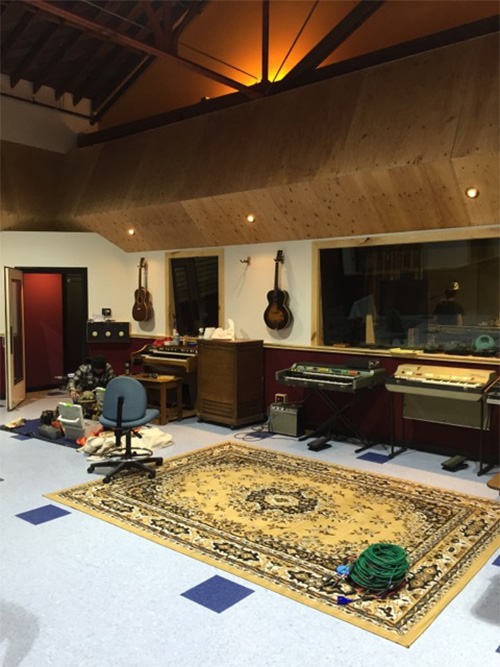
TTO's sizeable live room with 23' ceilings
You’re building a large format, purpose-built commercial recording facility in 2016. Have you been to a doctor lately? Has anyone tried to talk you out of this?
Oh yeah. People who love me tell me I’m insane. And they’re sort of right. From a financial standpoint -- and what I should be doing with my time and energy -- it doesn’t make sense on paper. But you’ve gotta play to win. The analog recording revolution is coming and the openings are there for people starting analog recording studios in poorly served major markets.
Oakland is a poorly served major market? You think musicians will make the migration from San Francisco to make their record at TTO?
The two cities are very much overlapping. There are three million people in the Bay Area now, and it’s just as likely that we’d have someone from San Francisco go to Oakland to a make a record as vice versa — and we also have a high percentage of people from out of town, 50 or 60 percent each month.
Have you been doing sessions in Oakland while the studio was being built, before it was “open?”
No. And we’re booked until late August — but we’re still not totally prepared, and it’s not for lack of trying. All day, every day, my time is all about getting ready to open the room.
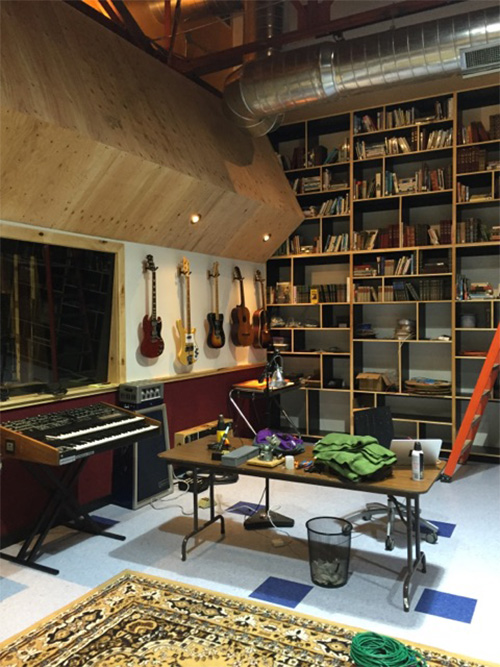
Note the unassuming Sequential Circuits Prophet 10
Your first session is in less than a week. So it’s better to have the studio most of the way there when the “Open” sign flips on, and then iron out the creases...
There are so many moving parts in a studio, it takes at least six months to really get it right. We have a very smart and very intellectually aggressive room tuner named Manny LaCarrubba. Manny worked at the Record Plant and is a total badass. He’s a very old-school, sharp, opinionated acoustician. His philosophy is to always “undertreat” a room, live with it for six months and then shut down for a month if you have to and finish it. That’s the only way to fly. No one does that.
A lot of what you get with modern studio design has more to do with interior decorating…
Yes. And we did everything else. We put drum sets and instruments in there and took all the measurements with Manny, and it’s too live in there right now. The reverb time is a little over a second. But gobos and carpeting and the bodies of band members can totally deal with a bit of that. I want a diffuse, reverberant room. What else is the point of being in a large room?
If it gets to be a problem, you can move the microphone closer.
Absolutely. And if you want to go “Tchad Blake” on a drum set, we have two iso rooms. Put some tea towels on the drums and close mic them.
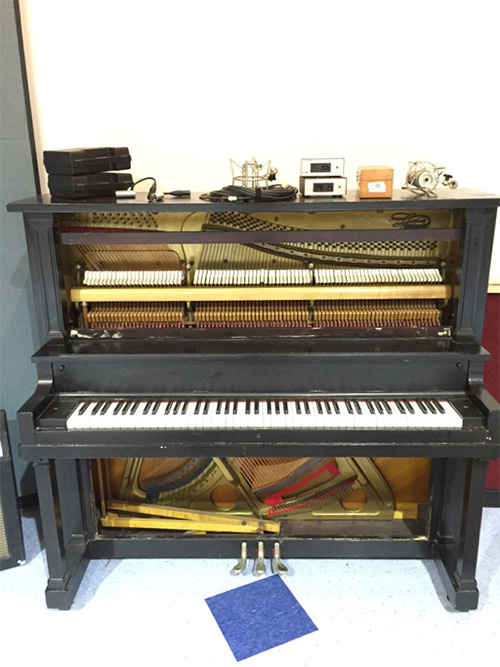
A vintage upright, fully exposed
What’s your plan for splitting time and energy between San Francisco and Oakland? Do you have separate studio managers? Separate in-house techs?
I wish we had those kinds of decisions to make. Right now, I do all that stuff. I book all the rooms, I manage all the rooms, I drive back and forth. Even with three sold-out studios, when we’re keeping the rates so low, there just isn’t the kind of money for us to have that kind of staff. But the people who work here are badasses. There’s so much self-regulation at these studios. Right now, it’s working.
When I was coming up, all of my mentors told me the same thing: Find market value and price your services just above that. Weed out the tire-kickers, garbage records and people who aren’t ready for a studio. You have done just the opposite.
Because I totally disagree with all of that. That’s a tragic mistake. I get resumés every week from recording engineers with multiple Grammy nominations who are groveling to me for a staff engineer position, and I respectfully say no every time. And the reason is that they don’t have a clear philosophy on exactly this. They’ve priced themselves out of the market and now they’re coming back down to earth. You can’t do that. It doesn’t work that way.
For 18 years, people have been telling me to raise my rates. It’s unbelievable how often studios that aren’t booked tell me that I need to raise my rates. If you’re not booked on Thanksgiving, Christmas Eve and New Year’s Day, you’re over market. We have all three studios booked on July Fourth this year. You could have a tent with a wire recorder on the side of the 101 in Orange County and be sold-out if the price is right.
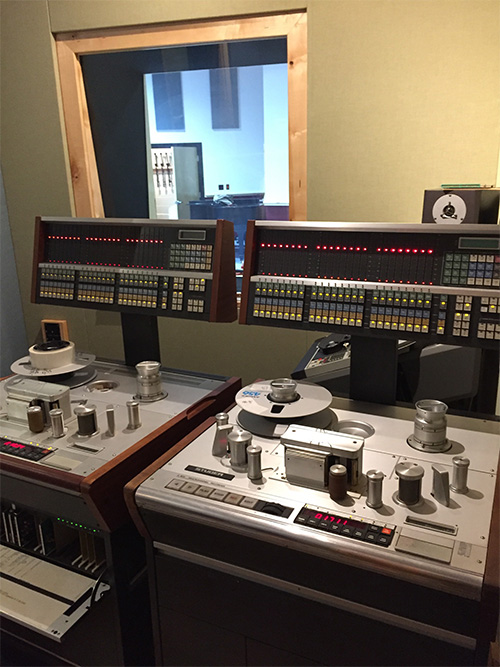
A pair of Studer A820 tape machines
It happens to bands, too. They get addicted to playing $10,000 festival gigs, and then it’s really hard for them to step back down into clubs. You’ve gotta stay street-level at all times. Once you lose touch with the street, and the bands that are up and coming, all you have left is the dregs. These bands don’t wanna go play at the Troubadour.
Which is ridiculous! A moderately big band could play a very cool show at the Troubadour that sells out in 15 minutes and —
[Best interruption ever] And you’ve gotta run tape machines. It’s clear to me. You have to run tape machines or else you’re just some other place with a Mac Pro. No one cares. No one gives a shit. And we have to have Pro Tools in every room, or else we’d be telling clients that they can’t have 24bit/96kHz digital backups of their multitracks and mixdowns.
But the best of what we do is providing low-cost, high-quality analog recording. That’s what these bands should be taking advantage of. It’s maybe one time in 40 that a band comes in and is totally uncomfortable working in a linear recording format like tape. They’re too nervous. And hey, no judgements from us. We just say “Here’s your stuff in hi-res digital, here’s where you should go next. We love you.”
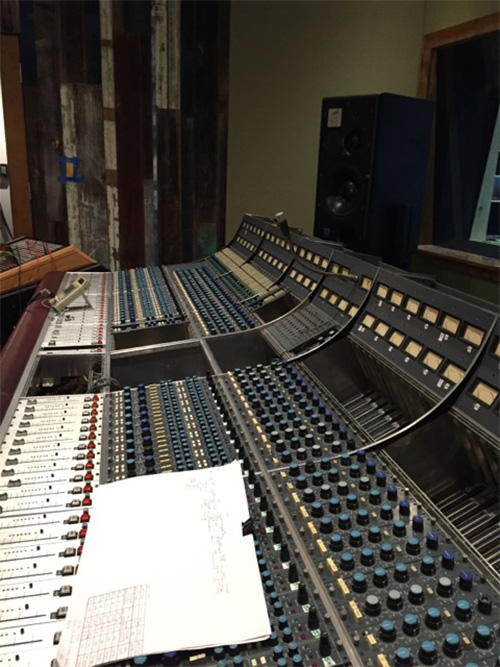
64-channel Neve 8068 being commissioned
There are some places that are way anti-computer.
And there are probably some studios that don’t serve coffee, too.
I’ve been following the restoration of TTO’s console closely on social media. Tell me about the desk, this beautiful doublewide Neve 8068. Did Fred Hill or someone else bolt that together long ago, or was it custom-factory-ordered...
Here’s my understanding of it: One of the 8068s came from Germany, one of them made a short trip from LA, and then the two were joined at The Plant in LA. I know that Fred Hill was one of the techs at some point during that time. I don’t know if he was on the joining or if he just did work on the console afterward or what. But The Plant went so fuckin’ bankrupt, so quickly. That console had been off in a room at The Plant for 10 years, just sitting in a time capsule. So when we opened the modules up and looked at the switches and everything, it did not look like a console that was built in 1976. All of the 31102 input modules were in perfect condition.
I’m working with Garry Creiman, a total genius Neve tech who used to work at Ocean Way. First thing he said when I got the console was that if he was going to do this console and put his name on it, he was going to rip out everything and start over and it was going to take a long time. Someone had done some SSL-type mods and added extra functionality, and he wanted to get rid of it. And I don’t like that stuff anyway. I don’t even like automation. We cut the strings on the GML fader automation immediately.
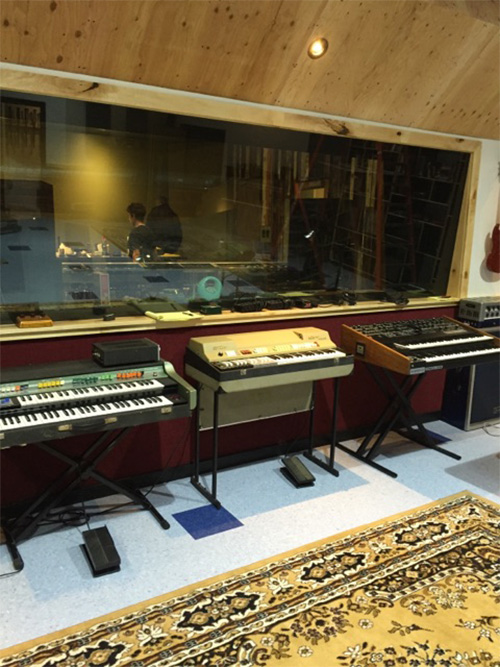
TTO is not exactly lacking in vintage keys
I said, “Let’s do it in slo-mo over the next two years, so I can actually pay you for it,” and then he flipped the thing onto its back and rewired the entire console. He stripped everything out, tested every component in every module, de-modded the entire console, and then took out the in-line functionality. We just don’t need it. It’s a 64-channel 8068.
What were the absolute worst and absolute best deals you’ve gotten when buying a piece of vintage gear?
Worst is easy. I bought a Quantum Audio Labs prototype console locally for, like, $7,000. Not only was Quantum Audio a very small, very customized manufacturer, but this was a prototype. This was when I was beyond naive. Some Steely Dan record had been mixed on it, or something, and that was its reference point for me. It really didn’t sound good, was broken and had to be heavily modded. It singlehandedly ruined my whole year. I probably put another $7,000 in tech work into it and then felt very happy to have gotten rid of it for $1,000. My immediate reaction to that experience was to buy a Neve console. I went to the bank and took out a loan, and that’s the console that’s been in Tiny Telephone A for almost 20 years.
The best deal was one that I totally didn’t see coming. I bought a Moog Source — the first programmable Moog — for $700 in the late ‘90s. Nowadays, that synth has a little more cachet, but at that time it was seen as kind of a loser, later-era Moog. But that synth taught me the basic architecture of a monophonic analog synth. The battery would die immediately, and it wouldn’t save sounds, but I toured with it extensively. I would put together patches on stage during the show and tell the crowd what I was doing.
But it’s worth it. Good gear should teach us something and usher us into a new level of productivity. It should raise the bar for what a good sound really is. The Source has a great depth of sound, and the low-end on that thing is ungodly. It taught me the importance of doing bass lines on a keyboard. In the studio, I’d build out chords on the Source rather than using a polyphonic synth. Today, I’d be happy to pay $1,500 for one.
And if you see any below that, hip me to it. I want one now. Anyhow, I’m gonna let you go — my poor dog is staring at me, wondering why she isn’t going outside.
And I’ve got to take care of my cats! Animals are the best thing in the whole world. Take care of her, and thanks so much for the interview!
Studio Grade Gear